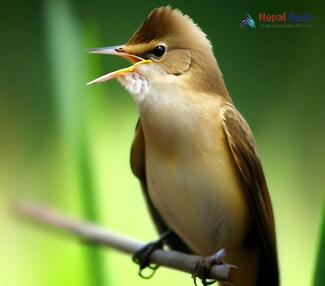Nepal is well-known for its stunning landscapes, diverse wildlife, and rich cultural heritage. With over 800 species of birds inhabiting its various ecosystems, it's no wonder that this Himalayan nation is a paradise for birdwatchers and nature enthusiasts alike. One such fascinating bird that can be found in Nepal is the Clamorous Reed Warbler (Acrocephalus stentoreus). The melodic calls of this unique species, which is characterized by its boisterous song, make it impossible to miss. In this article, we'll explore the captivating world of the Clamorous Reed Warbler.
Habitat and Distribution
The main habitat of the Clamorous Reed Warbler lies in and around wetlands, marshes, and reed beds. They thrive in areas with dense vegetation that provides ample cover for nesting and protection from predators. Though native to Nepal, their range extends across South and Central Asia, down to Southeast Asia and up into parts of Eastern Europe.
Appearance and Identification
The Clamorous Reed Warbler is a medium-sized warbler, measuring about 18-20 cm in length. Its plumage consists of a combination of warm brown above and buffish-white below. The bird has a distinctive pale supercilium (eyebrow) that contrasts with its dark eye stripe, giving it a seemingly familiar yet characterful expression.
Vocalizations
What sets the Clamorous Reed Warbler apart from other species in the Warbler family are its incredibly loud and melodious calls. As the name suggests, they have a definite clamor about them – an incessant chatter accompanied by a variety of distinct notes. These songs are used primarily for establishing territory and as mating calls during the breeding season.
Breeding Cycle
The breeding season for Clamorous Reed Warblers typically begins in late spring and lasts through the summer. The males sing their hearts out to attract a mate, weaving a complex repertoire of notes that can carry for long distances. Once pairing is established, nests are built close to the water and well-hidden within reeds or tall grasses. Female warblers lay between 3 and 5 eggs, which are incubated for around two weeks before hatching. Both parents take turns feeding their chicks until they're ready to fledge.
Conservation Status
Clamorous Reed Warblers are widespread throughout their range and are not considered to be at significant risk of extinction. However, continuous loss of wetlands due to human interventions like draining marshes for agriculture could pose a potential threat to their habitat in the future.
In conclusion, the Clamorous Reed Warbler is a captivating creature that has made a home for itself amidst the lush marshes of Nepal. With its resounding songs and remarkable resilience, this enthralling bird species continues to hold its place in the hearts of birdwatchers and wildlife enthusiasts alike who traverse Nepal's stunning wilderness in search of these melodic treasures.




